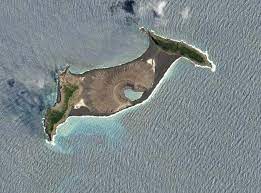
New Zealand and Australia sent military surveillance flights to Tonga on Monday to assess damage caused by a huge undersea volcanic eruption in the Pacific island nation.
A towering ash cloud that rose after Saturday’s eruption had prevented earlier flights. New Zealand said it hoped to send essential supplies, including much-needed drinking water, on a military transport plane on Tuesday.
No casualties have been confirmed on Tonga, although a British woman was reported missing.
The British Foreign Office said it was “supporting the family of a British woman reported missing in Tonga and are in contact with the local authorities”.
Relatives of Angela Glover, who ran an animal rescue centre in Tonga’s capital, said she has not been seen since she was swept away by a tsunami wave. Her husband, James, survived by clinging on to a tree.
Glover’s brother Nick Eleini told The Guardian: “I don’t think this is going to have a happy ending.”
Communications with Tonga remained extremely limited on Monday. The company that owns the single underwater communications cable that connects the island nation to the rest of the world said it was probably severed in the eruption and repairs could take weeks.
The loss of the cable leaves most Tongans unable to use the internet or make phone calls abroad. Those who have managed to get messages out described their country as looking like a moonscape as they began cleaning up after the tsunami waves and volcanic ash fall.
New Zealand Prime Minister Jacinda Ardern said boats and coastal shops were damaged by the tsunami.
There were still concerns about people on some of the smaller islands near the volcano. The tsunami waves crossed the Pacific, drowning two people in Peru and causing minor damage from New Zealand to Santa Cruz, California.
Scientists said they did not think the eruption would have a significant impact on the Earth’s climate.
Huge volcanic eruptions can sometimes cause temporary global cooling as sulphur dioxide is pumped into the stratosphere. But in the case of the Tonga eruption, initial satellite measurements indicated the amount of sulphur dioxide released would only have a tiny effect of perhaps 0.01ºC global average cooling, said Alan Robock, a professor at Rutgers University.
Satellite images showed the spectacular undersea eruption Saturday evening, with a plume of ash, steam and gas rising like a giant mushroom above the South Pacific waters.
A sonic boom, which could be heard as far away as Alaska, sent pressure shock waves around the planet twice, altering atmospheric pressure that may have briefly helped clear fog in Seattle, according to the National Weather Service. Large waves were detected as far away as the Caribbean due to pressure changes generated by the eruption.
A second undersea cable that connects the islands within Tonga also appeared to have been severed, Fonua said. However, a local phone network was working, allowing Tongans to call each other. But he said the lingering ash cloud was continuing to make even satellite phone calls abroad difficult.
Aid agencies said authorities had asked people to wear masks and drink bottled water owing to thick ash and smoke.
In a video posted on Facebook, Nightingale Filihia was sheltering at her family’s home from a rain of volcanic ash and tiny pieces of rock that turned the sky pitch black.
“It’s really bad. They told us to stay indoors and cover our doors and windows because it’s dangerous,” she said. “I felt sorry for the people. Everyone just froze when the explosion happened. We rushed home.”
Outside the house, people could be seen carrying umbrellas for protection.
Covid-19 measures complicate disaster response
One complicating factor to any international aid effort is that Tonga has so far managed to avoid any outbreaks of Covid-19. Ardern said New Zealand’s military staff were all fully vaccinated and willing to follow any protocols established by Tonga.
Dave Snider, the tsunami warning co-ordinator for the National Tsunami Warning Center in Palmer, Alaska, said it was very unusual for a volcanic eruption to affect an entire ocean basin, and the spectacle was both “humbling and scary”.
The US Geological Survey estimated the eruption caused the equivalent of a magnitude 5.8 earthquake. Scientists said tsunamis generated by volcanoes rather than earthquakes are relatively rare.
Rachel Afeaki-Taumoepeau, who chairs the New Zealand Tonga Business Council, said she hoped the relatively low level of the tsunami waves would have allowed most people to get to safety, although she worried about those living on islands closest to the volcano.
“We are praying that the damage is just to infrastructure and people were able to get to higher land,” she said.
The explosion of the Hunga Tonga Hunga Ha’apai volcano, about 64 kilometres north of Nuku’alofa, was the latest in a series of dramatic eruptions. In late 2014 and early 2015, eruptions created a small new island and disrupted international air travel to the Pacific archipelago for several days.
Earth imaging company Planet Labs PBC had watched the island in recent days after a new volcanic vent began erupting in late December. Satellite images showed how drastically the volcano had shaped the area, creating a growing island off Tonga.


